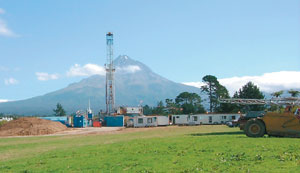Looking ahead
Dec. 2001 Vol. 222 No. 12 Looking Ahead New Zealand unveils biggest round in 10 years. New Zealand will hold a major licensing round for the Taranaki basin. Offerin
New Zealand unveils biggest round in 10 years. New Zealand will hold a major licensing round for the Taranaki basin. Offerings include permits for 20 onshore and six near-shore tracts in water depths as great as 3,280 ft. The blocks will be allocated by competitive, staged, work program bidding, said the government’s Crown Mineral’s unit. Deadline for bid submission is April 30, 2002. The Taranaki basin covers a wide swath along the west coast of the country’s North Island. This year, production through July was reported at 220 Bcfg and 13 million bbl of oil. The basin has great potential for future discoveries, as indicated by recent finds, the irregular distribution of field sizes and the basin’s geological complexity.
Pause expected in the Barents Sea. Norway’s newly appointed oil and gas energy minister, Einar Steensnaes, said there will be a pause in oil and gas development in the Barents Sea after the start up of giant Snoehvit field. The pause, which could last a couple of years, will allow the government to assess the project’s full impact on the environment, said Steensnaes. He added, "We will have to take time to safeguard the climate, fishing and the environment." He said no delay is foreseen, and the Norwegian parliament is expected to approve the $5.2-billion Statoil project in time for its scheduled construction commencement date of March 1, 2002. Snoehvit, the first development in the Arctic Barents Sea, is estimated to hold 320 Bcmg. The next project due for development in the Barents Sea is Goliath field, where Eni recently struck oil. Western Australia offers new North West Shelf acreage. The Western Australian government expects competitive bids for three prime exploration blocks in state waters of the North West Shelf. The Department of Mineral and Petroleum Resources (MPR) formally released the blocks during its Petroleum Open Day in Perth. Two of the three blocks are west of Dampier, and one is near Western Australia’s largest oil field, Barrow Island. All three blocks are close to existing discoveries and infrastructure, which enhances their development potential. Seismic data from previous surveys are available through MPR. Successful applicants will be chosen via work program bidding, and announced next year. Bids close Feb. 28, 2002. BP sees its U.S. production up 33%; Knowles urges Alaskan gas project. BP Plc expects its U.S. production to increase 33% by 2005. Deputy Chief Executive Rodney Chase said the firm would invest $6 billion in the U.S. this year and a similar amount in 2002. The company’s daily U.S. output totals about 750,000 bbl of oil and 3.6 Bcfg. The London-based firm greatly expanded its U.S. presence with recent acquisitions of Amoco and Atlantic Richfield (ARCO). Meanwhile, Alaskan Governor Tony Knowles remains confident about prospects for a pipeline delivering natural gas from Prudhoe Bay to the Lower 48 states. "At a time when we are talking about security, about access to energy, this could not be a more timely project," Knowles told an appointed task force that is investigating the gas project issues. However, controversy surrounds the proposed routes the pipeline may take. Oil firm calls for drive on saving energy. ExxonMobil is calling for accelerated research into energy-saving technologies. ExxonMobil Senior Vice-President Rene Dahan said, "We would see some funding on our side" to launch an international public and private sector research effort into more efficient energy generation and use. ExxonMobil opposes the 1997 Kyoto Protocol, which mandates industrialized countries to cut carbon emissions by 5% between 1990 and 2010. However, Dahan admits that "an aggressive but voluntary program for managing carbon" with new technology is needed. He added, "If climate change is confirmed in 10 to 15 years’ time, we cannot afford to get there to find that the only way of dealing with this is to choke off world economic prosperity." Delegates to the United Nations conference on climate change met in Morocco to seek agreement on creating a legal text out of the political deal reached in Bonn in July, when 178 countries decided to proceed with the Kyoto Protocol, despite of the U.S. decision to abandon it. Energy Africa to raise $200 million. Energy Africa plans to raise $200 million by 2003 to fund developments that could double its output in the next four years. Managing Director Rhidwaan Gasant said the group plans to invest $250 million to $300 million in developments in Namibia, Equatorial Guinea, Congo and the UK. It also hopes to increase its reserves by drilling seven additional exploration and appraisal wells over the next six months. The work will be funded through strong cash flow, planned debt and equity. The group already has grown its production almost fourfold since it listed in Johannesburg and Luxembourg five years ago. Its 2001 first-half net profits jumped from $8.7 million to $22.1 million. Cairn confident about India interests. Cairn Energy is growing increasingly confident that its interests in the Krishna-Godavari basin, offshore eastern India, are economically viable. Test results for its fourth consecutive deepwater find in Block KG-DWN-98/2 flowed about 6,000 bopd and 3.9 Mcfdg. They also indicated recoverable reserves of 40 million to 60 million bbl, bringing the block’s total net reserve potential to at least 200 million boe. Cairn has evolved into the foreign oil firm with the largest working interest in the region. |
- Applying ultra-deep LWD resistivity technology successfully in a SAGD operation (May 2019)
- Adoption of wireless intelligent completions advances (May 2019)
- Majors double down as takeaway crunch eases (April 2019)
- What’s new in well logging and formation evaluation (April 2019)
- Qualification of a 20,000-psi subsea BOP: A collaborative approach (February 2019)
- ConocoPhillips’ Greg Leveille sees rapid trajectory of technical advancement continuing (February 2019)



